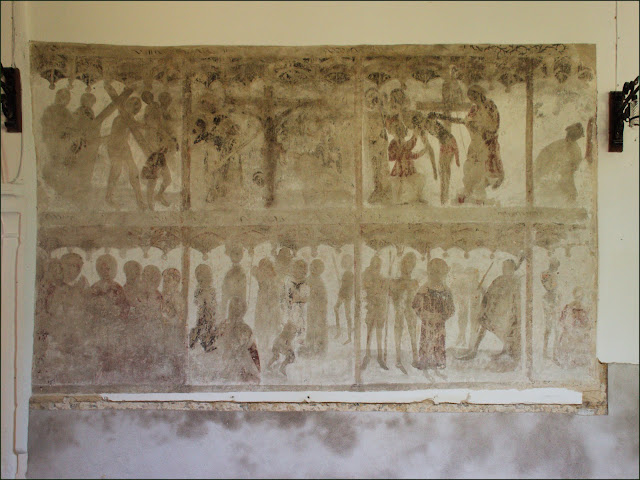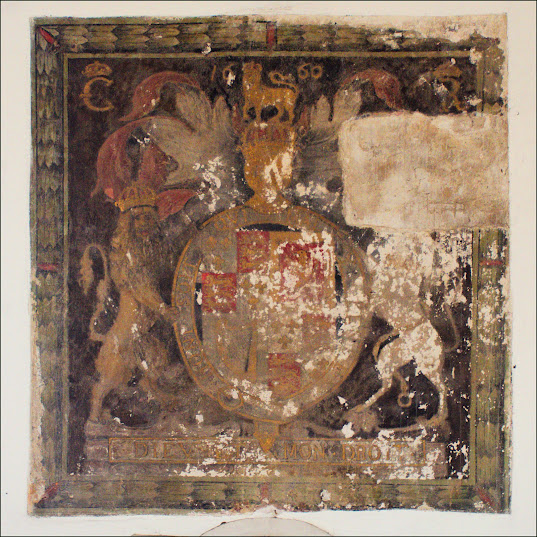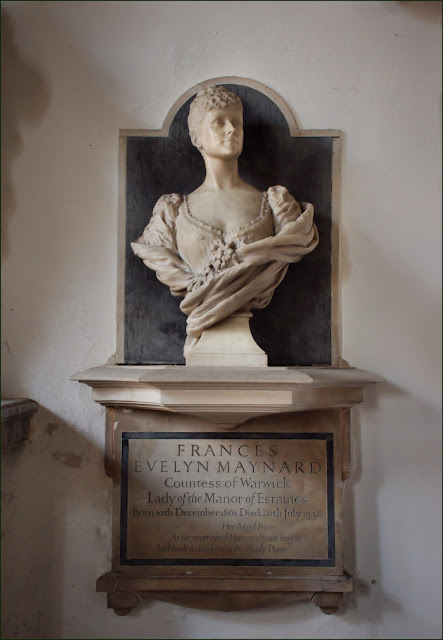I couldn't resist. I just had to pop into Little Easton Church while we were in the area.
Exactly what do I like about these old buildings? Well, sometimes they are attractive buildings in their own right. Most date from a time before the trade of architect was invented, but those who built them put all their taste and skill into every aspect of construction. Then others, because of their situation and atmosphere, exude a deep sense of peace - even to an old heathen like me. But most of all they stand as monuments to the passing centuries and the people who have gathered here.
I could easily tell you that this church is twelfth century, but that doesn't tell you half the story; that's just the opening sentence in a long and mysterious tale that is peopled by a huge cast of curious characters.
At some stage, very soon after the nave of the church was built, it was decided that the walls should be decorated with icons. This is reckoned to be a representation of a prophet. Peering intently at it raises more questions than it answers. I'd like to know the person who painted it and from where he received his instruction and inspiration. We do know a little about the men who were in charge here in the early days.
A record of their names has been preserved and a board has recently been made for us to peruse. It seems that a lot of them were called "John", but one was known by the name of "John At Hell"(!) Now, what sort of name is that? What kind of rector might he have been? They also seem to have got through some dozen rectors in just over 50 years. Was that when the Black Death was visiting this tranquil backwater?
Perhaps the Rev At Hell would be able to help me out with my next conundrum. In the chancel there is an old tomb and on top of it reclines a knight in armour. You'll find something like it in many churches, but this one is different. All the others are life-size or thereabouts, but this chap is only about two feet (60cm) long. Now I've heard of the Elfin Knight, but that's ridiculous.
After the church had stood for a couple of hundred years more wall paintings were needed, and this one is huge. You'll often read that these served as a Bible for those who were unable to read, which was pretty much everybody. But church services were very different in those days. There was no sermon - and no seating. There was a good deal of walking around to various icons painted on the walls. The priest intoned prayers in Latin and the layman can have had little understanding of what was going on.
It became the clergy's job to say prayers for the dead - or at least the wealthy among them - and some time in the fifteenth century the South Chapel was built for the purpose. It's to the left of the first picture I showed you of the church. The stained glass dates from 1621 when it was made for the Maynards' private chapel and wasn't moved here till 1857.
Sir Henry Maynard and his wife, Lady Susan Pearson both died in 1610 and had this enormous alabaster memorial erected so that we should not forget them. Their children are shown kneeling in prayer. Some are set further back from the others, representing those who pre-deceased their parents. Sir Henry's wealth could do nothing to protect them from that tragedy.
Sir Henry, despite his armour, was a politician rather than a fighting man and rose to become Deputy Lieutenant of Essex. He was born in Devon and presumably moved here when he married Lady Susan who had been born in Little Easton.
Frances Cavendish, who became another Lady Maynard on her marriage, has a memorial tucked into the corner of the chapel - and has the indignity of sharing the space with some plastic stacking chairs. She died at the age of just twenty as she gave birth to her third child. Her husband paid for this memorial.
And a huge memorial to him stands close by. And so these reminders of the great and wealthy of the parish pile up across the centuries.
1660 saw the artist of the village once more required to mount his step ladder and commit paint to plaster, much in the fashion of his medieval ancestors. This time it was King Charles I who needed his coat of arms to seen in every church in the land. The passing years have given a patina of shabby grandeur to the once brilliant hues.
The Victorian age was a great time of church restoration - sometimes saving buildings from decay and sometimes tearing down what was good and replacing it with the ugly and inappropriate. The colour of the glass, with lots of strong reds and blues, is typical of that age, as is the sentimental subject matter of Faith, Hope and Charity.
Charles Chambers of Balsham in Cambridgeshire made the wooden cover to this old font in the early years of the twentieth century and there's an unobtrusive notice recording this contribution to the fabric of the church.
As we saw in the previous post, many famous people visited the little village in the early years of the twentieth century. One such was the actress Ellen Terry who loved to visit the church. This odd little plaque was erected by her friends on her death in 1928.
And here's our friend Frances Evelyn Maynard, or Daisy Countess of Warwick, who died in 1938, just before the outbreak of the second world war and the coming of British and American forces to the peaceful scene.
And they are remembered too, through two colourful modern windows in the North chapel.
We've come a long way from the days of Rev John At Hell, but to bring our story round to an appropriate conclusion we need to go out into the churchyard and seek out a gravestone from the year 2000.
Another Rev John, this time John Michael Filby aka "The Rocking Reverend Jack Filby....Promoted to Glory 4th October 2000....Wearing his cross, his cowboy hat and boots....he played his guitar...🎸...Now sings my soul"
Take care.




















An amusing and informative narrative. Many would visit the church and not notice many of the things you have highlighted. I will now have the ear worm of 'Now sings my soul' repeating for the rest of the day as I frantically try and remember the rest of the words.
ReplyDeleteThank you so much for this informative and fascinating look inside the church. So many untold stories...
ReplyDeleteThe sculptures do it for me. They are just looking magnificent
ReplyDeleteThe churches are a place that shows the skills of the craftsmen of that time and times following. Often enough other evidence has long gone elsewhere.
ReplyDeleteGood to see the painted walls...so many were whitewashed over...some lost, some preserved by the over painting!
So good to see you back on form John. Exquisite church - love the roof incidentally) and to be taken on a tour of that exquisite building. x
ReplyDeleteRichard Dawkins, a firm agnostic and probably an atheist, confesses himself to be a cultural Christian, and I suspect this might define you too, John.
ReplyDeleteLove the old churches you feature, John. Thank you!
ReplyDeleteA beautiful church with so many interesting features and former incumbents and worshippers too:)
ReplyDeleteSuch an interesting church. I am intrigued the the Elfin Knight and the memorials there are stunning. Great to see the wall paintings have survived. I do love reading about the history of churches and the way the church seems to soak up the atmsphere of parishioners over centuries.
ReplyDeleteA beautiful old church and sculptures. Thanks for the tour, John.
ReplyDeleteWhat a wonderful tour you gave John, The small effigy could he have been a dwarf or child. I've seem many tomb effigy's and am always amazed at the number of kids they had a times. One near me had fourteen kids around the Tomb. BTW it the south aisle on the right in the photo, the north is to the left your looking east to the altar
ReplyDeleteThanks for your comment, Bill. It may be that the effigy is a child, though it does seem to be wearing a full suit of chain mail. What always saddens me is the number of women who died in their late teens to early twenties, probably during childbirth. Just to clarify: the South Chapel is on the left of the first photo (the outside of the church) in the first photo, as I said. The second photo, inside of the church, has the South Chapel to the right as you look down towards the altar.
DeleteWonderful post. So much interesting history (and mystery) it kind of boggles the mind!
ReplyDeleteAnother beautiful church. I can almost feel the atmosphere. I always wonder do you know all this history or do you have to look up information to tell us? I always feel that you know it...or at least a big part of it.
ReplyDeleteI know the general history of these islands and the churches reflect most phases as they affected people in each village. But there are thousands of churches across the land and every one is different - obviously I don't know these details. There's a lot online and most churches are proud of their history and make it easy for visitors by producing little guidebooks and displaying explanatory notices.
DeleteOld churches (and other buildings) have their almost inexplicable charm, because of their beauty, history, importance.
ReplyDeleteWhere I live, this kind of fascinating buildings can't be found but reading your posts I can immerse myself in contemplating the old times. :)
Thank you and take care.
Totally agree with you, Sara.
DeleteThere is such a lot of history in that church and in the whole village, John.
ReplyDeleteThe building acts as a community history repository, it seems to me. Not necessarily written down, but preserved through the paintings, carvings, sculptures, etc. I like this way of telling the story, where future generations are left to decipher, wonder, and imagine.
ReplyDeleteHi John - well this is fascinating to read ... so much history and well recorded, and kept in good order. Interesting about Ellen Terry - I hope to get to see her Beetle dress when it returns to Smallhythe ... thanks John - that was brilliant, excellent photos - cheers Hilary
ReplyDelete